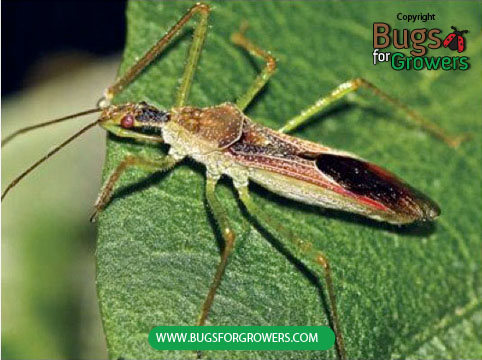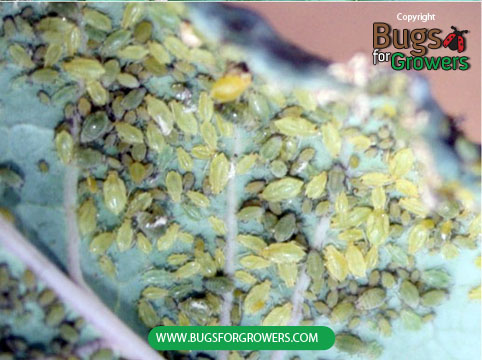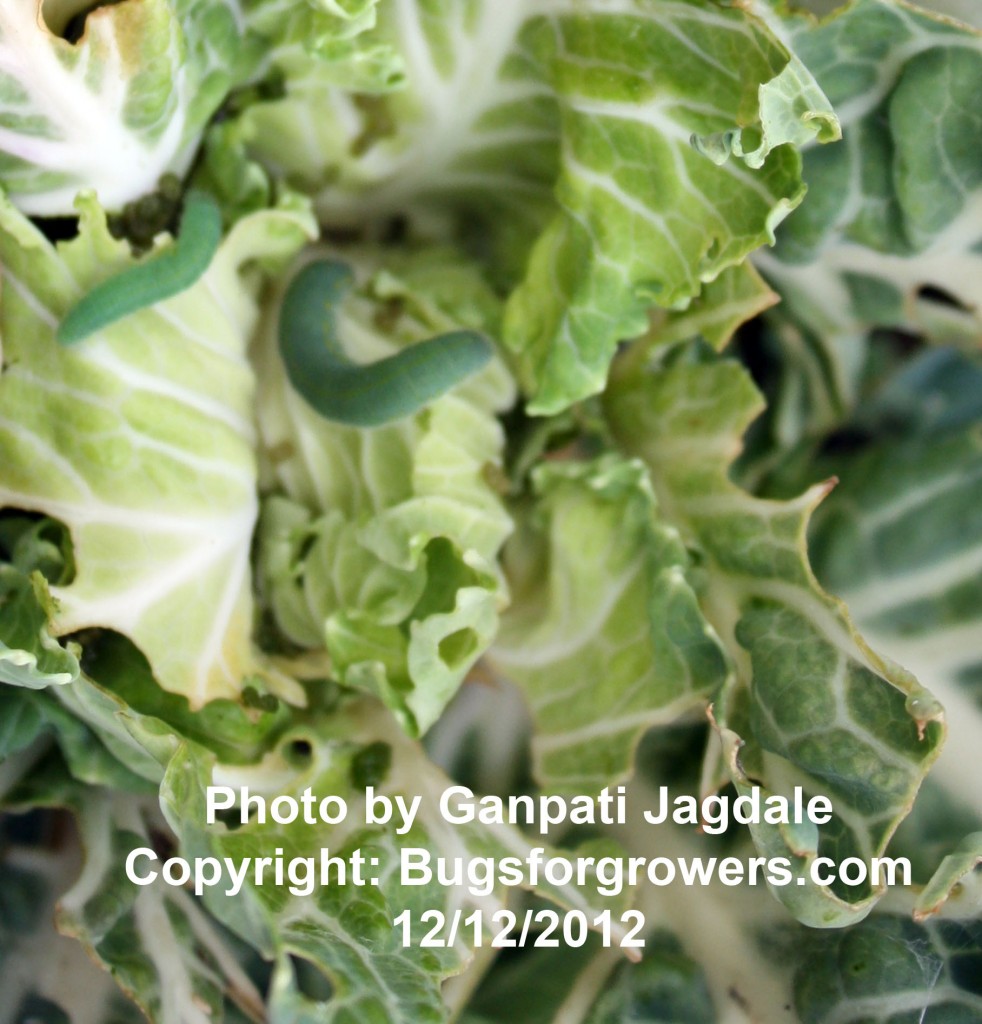What are predatory assassin bugs?
Predatory Assassin bugs, Zelus renardii (Photo 1) are the most effective predators of many soft-bodied insect pests. Adults of assassin bugs are medium in size (about 1/2 to 3/4 inch long) and blackish brown in color with red eyes. Females lay eggs in clusters on the leaves or in the soil. Eggs hatch within a week into small nymphs (larvae) that look like their parents but they have no wings. Both adults and nymphs have beak- like mouthparts that they use for piercing and sucking the body content of their insect hosts.
Which four insect pests can be managed with assassin bugs?
Assassin bugs are currently used for the control of aphids, cabbage looper, diamondback moth and imported cabbage worms damaging many cruciferous crops including broccoli, Brussels sprouts, cabbage, Chinese cabbage, cauliflower, collard, kale, kohlrabi, mustard, radish and turnip.
1. Aphids
Aphids (Aphis spp) are tiny insects (Photo 2) that cause both direct and indirect feeding damages to all the above stated cruciferous crops. In case of direct damage, aphids directly suck juice from all the tender plant parts like buds, flowers, twigs and leaves using their piercing and sucking type of mouthparts. The symptoms of direct feeding damage by aphids include yellowing and curling of leaves (Photo 3) and reduced plant growth.
In case of indirect damage, they secrete honeydew- like substance that stimulates the growth of black sooty mold (Photo 4) on the surface of the infested leaves. This black sooty mold badly affects the process of photosynthesis, the quality of the produce and aesthetic value of many ornamental plants.
Aphids also transmit different types of viruses from plant to plant. For example, bean common mosaic virus, carrot virus Y, celery mosaic virus, cucumber mosaic virus, Johnson grass virus, lettuce mosaic virus, papaya ring-spot virus, potato virus Y, turnip mosaic virus, watermelon mosaic virus and zucchini yellow mosaic virus. These viruses cause yellowing and curling of leaves, stunted plant growth that can lead to a tremendous economic loss to the vegetable industries.
2. Cabbage looper
Cabbage looper (Trichoplusia ni) moths are mottled grayish brown in color with a whitish spot at the center of each of their forewings. The hind wings are dark colored with a whitish brown fringy border. In the life cycle of cabbage looper there are four developmental stages including eggs, larvae, pupae and adults but only larvae cause serious damage to many above stated cruciferous crops especially cabbage grown in the fields and organic gardens.
Cabbage looper females lay over 300 greenish or whitish eggs on the leaves. Eggs hatch into small green larvae within 7 days. Mature larvae are pale greenish in color with a white strap on each of lateral sides and about 41 mm long with narrower mouth regions and wider tail regions. Pupae of cabbage loopers are green to brown in color.
Of the five larval stages, the first three young stages feed on the lower side of the leaves keeping the upper part of the leaf intact whereas the fourth and fifth stages chew holes in the center of leaves without damaging leaf margins. In addition to leaf damage, these larvae can feed and destroy the growing point of the cabbage head.
3. Diamondback moth
Diamondback moth (Plutella xylostella) got its name because of a distinctive diamond shaped pattern on its back. Diamondback moths develop through four developmental stages including eggs, larvae, pupae and adults but only larval stages cause damage to many above stated cruciferous crops.
Female moths lay oval shaped and pale yellowish colored eggs on the leaves. Eggs hatch into small larvae that have typical body shape tapering at both head and tail ends. The presence of a pair of pro-legs at the tail end of the larva gives them a distinguishing “V” shape. First stage larvae are light yellow whereas matured larvae are green in color. Mature larvae are about 10-12 mm long with distinctive white marks on their body. When disturbed, these larvae wriggle quickly, move backwards and get away by spinning down on a silken thread.
Newly hatched first stage larvae mine into leaf tissues and feed internally. The first stage larvae molt into the second stage and then move out of the mines and start feeding externally on the underside of the leaves. Typically these larvae scrape the lower surface of the leaf and leave its upper surface intact giving a see-through window effect. Scraped tissues then dry, crack and create holes on the leaves. In case of severe infestation, diamondback moth larvae can completely skeletonize leaves that can lead towards the severe losses of crop yields.
4. Imported cabbageworm
Butterflies of imported cabbageworm (Pieris rapae) have whitish wings with one black spot present on the top of each forewing of their males whereas two black spots on the top of each hindwing of females. Also, both males and females have a black spot on the outer front margin of each of their hindwing.
Females lay singly yellow and oval shaped eggs on the either side of the leaves. Eggs hatch into small caterpillars within a week and they immediately start feeding on the lower surface of the leaves as well as growing points of cabbage and broccoli crops (Photo 5) . These larvae randomly chew large irregular holes on both young and mature leaves of different host plants.
In case of severe infestation, caterpillars can skeletonize the entire plant and also stop initiation of formation of cabbage bulbs. While feeding, caterpillars mature within 2-3 weeks. Mature caterpillars are velvety green in color with a narrow orange stripe down the middle of the back and a yellowish stripe along each side of the body.
These matured caterpillars then turn into light brown colored pupae that are generally attached to the bottom leaves by silken threads. Adults generally emerge from the pupae within 2 weeks. Depending upon temperature, imported cabbageworm can complete 2- 8 generations in a year.
How do assassin bugs feed and kill their insect hosts?
Once in contact with their host insects, the assassin bugs pierces the body of their hosts with their beak- shaped mouthparts and injects a toxin that kills their hosts within seconds. The toxin also liquefies the host tissues, which makes the assassin bugs to sucks up the body content through their hollow beak- like mouthparts easily.
When and how assassin bugs should be released?
- For low infestation of cruciferous insect pests, release 500 eggs of assassin bugs per 2000 to 3000 sq.ft. area every 2-3 weeks.
- For heavy infestation of cruciferous insect pests, release 500- 1000 eggs of assassin bugs per 2000 to 3000 sq.ft. area weekly.





